
“The three seed dealers in this area have said their seed sales indicate a 30 percent to 40 percent increase in cotton acres this year,” says Jay Hoover, Macon, Miss., who is growing the crop for the first time this year. And growers in the area say there are reasons to believe coming years will see more land coming out of soybeans and into cotton as irrigation capability increases and a new $6.5 million cotton gin begins operation this fall.
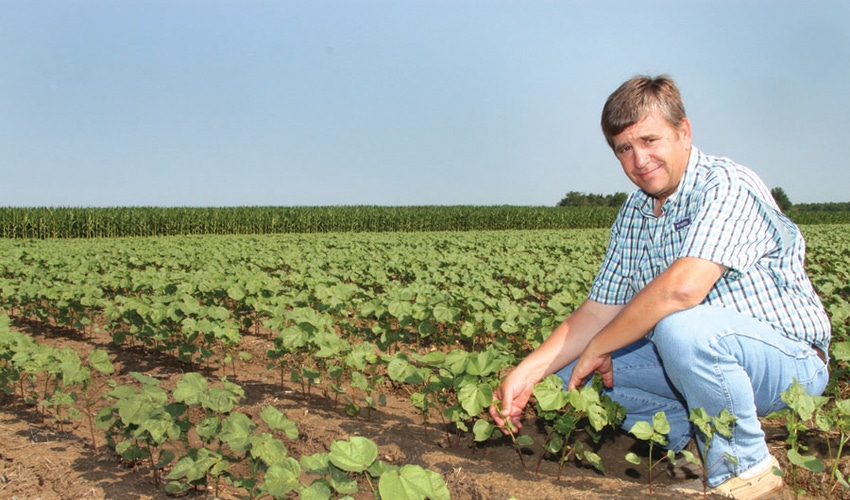
Jay Hoover has never grown cotton. But, this year the Macon, Miss., long-time grains and poultry producer has planted 330 acres on ground that would’ve otherwise been in soybeans.
His sons-in-law Kevin Shirk and Andrew Shirk, who work with him and also have separate farming interests, have planted another 100 acres. They’ve also invested in a six-row cotton picker, a module builder, and other equipment to pick family cotton and to do custom harvesting for other growers in the area who want to diversify into cotton, but can’t justify the equipment investment.
While cotton acres have declined sharply or stagnated in other areas of the state, Noxubee County — which in the late 1800s was Mississippi’s leading cotton production county — and surrounding counties are seeing a resurgence of acreage.
“The three seed dealers in this area have said their seed sales indicate a 30 percent to 40 percent increase in cotton acres this year,” Hoover says.
And growers say there are reasons to believe coming years will see more land going to cotton here and in adjacent counties. Key among them:
—Rapid increases in irrigation capability. While the area doesn’t have the Delta’s easy access to groundwater, many growers have constructed lakes and catchment ponds to feed center pivot systems. Some are also drilling wells, despite the 1,000 foot-plus depths required and costs that can run $175,000 or more for the well alone.
—Cotton yields, with irrigation, are consistently more reliable than irrigated soybeans on the heavy Black Belt prairie soils.
—The spectacular results of the 2011 season, when this area had among the highest cotton yields in Mississippi, and a number of producers set all-time yield records on their farms.
—The construction, now under way, of the new $6.5 million state of the art grower-owned Bogue Chitto cotton gin at nearby Brooksville, Miss., which will begin operation this fall, offering producers much closer ginning access.
In discussions with some of the area’s leading growers at the recent groundbreaking, these comments:
Jay Hoover, first-time grower
He farms 1,150 acres of corn, soybeans, and now cotton, and has six poultry houses, producing 6 million pounds of broilers per year. He has been selected by shareholders to be manager of the new gin.
“We decided last summer to get into cotton as a step toward diversification and for the rotational benefits,” he says. “My sons-in-law have had an interest in our getting into cotton and we decided to give it a try this year. They’ve taken over the day-to-day farm duties to free me up to work with the gin, but I’m enjoying watching the progress of our first cotton crop.”
He has planted three varieties, Deltapine DP 0912, DP 1034, and DP 1048 in equal amounts. “We based our choices on yield trials in this area and on recommendations from our cotton scout.”
The cotton, planted on stale seedbeds and fertilized with chicken litter from their poultry houses, is all dryland this year, but last fall they cleared some timber and fencerows and this fall plan to build a reservoir to feed center pivots. It will hold 350 acre feet of water and can supply three center pivots covering 400 acres.
“I already have one 15 acre lake in place and have a permit to drill a well for irrigation,” Jay says. “With our farm layout, we could potentially irrigate a maximum 780 acres.
“Drilling the well would be a major step, because of the investment required. In this area, we’d have to go 1,400 to 1,600 feet to get adequate water flow. You’re talking $500 an acre just for water, not counting the pump, wiring, and other costs. In years like 2011, when irrigation would’ve made a huge difference in corn yield, at $7 a bushel, it could be justified. But, we can’t expect that kind of scenario every year, and right now, I’m just not sure I’m ready to take on that kind of debt, so we’ll proceed one step at a time.
“I would anticipate, however, that we will increase cotton acres in coming years. Even with irrigation, soybeans just don’t get the same boost that cotton does. As we expand cotton and irrigation capability, we’ll rotate cotton and corn.”
The Masts: No more soybeans
Glenn and Rodney Mast, who farm 5,000 acres and have a farm equipment and irrigation dealership in Lowndes County, Miss., have made some significant changes in their operation this year.
They’ve had soybeans in their crop lineup for years, but have dropped them altogether this year in favor of cotton. They’ve also exited the catfish business they’d had for years, and will use the 120 acres of ponds as water source for center pivots.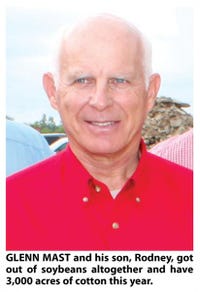
They’ve planted 3,000 acres of Deltapine DP 0912 B2RF, DP 1034 B2RF, and DP 1133 B2RF. “We have good experience with these varieties — they’re the cream of the crop,” Glenn says.
The Masts bought a new round bale John Deere module builder picker last year, which further cemented their decision to go more strongly into cotton this year.
“We absolutely love that machine,” Glenn says. “So much so that we’re adding another one this year. We got unreal savings on labor and equipment. One man and one machine picked 1,700 acres last year; previously, we had two pickers and seven men doing the same work. With an all-in-one picker, the logistics of equipment movement between our scattered fields is so much easier, too.
“It makes life so much simpler just to have two crops and the harvest efficiency of these new pickers. On our heavy prairie soils, soybeans are so erratic — we can occasionally brag about 72 bushel yields, but there are also years when we lament 8 bushel yields. With irrigation, we can get more consistent yields with cotton, and we can get more production with less water. Over 50 percent of our land is irrigated with center pivots fed from ponds and reservoirs.
“With water and the new varieties, these black prairie soils can consistently produce 1,000 pounds-plus.”
Noxubee County averaged 1,347 pounds last year, some of the highest yields in the state, Glenn says. “On our farms, we averaged 1,370 pounds.”
The Masts were enthusiastic supporters of the new gin, and are shareholders. Rodney, who is secretary, says projections show the new gin will save Noxubee County cotton growers $336,000 in hauling costs versus going to more distant gins.
“We want to the gin to be an attractive option for all producers in the area,” Glenn says; some cotton will also come from farms just across the Alabama state line. “We want to help farmers make money and keep growing cotton.”
Ben Harlow: Good rotation crop
He’d always had an interest in cotton, he says, but it wasn’t until 2005 that he tried a small acreage.
“It didn’t turn out well, and I didn’t grow any more until 2011, when the attractive price outlook encouraged me to try it again,” he says. “Last year was a great one for cotton in this area; some of the highest yields in the state were over here in the prairie region. Mine averaged 2.1 bales per acre.”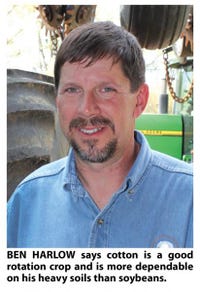
This year, he planted 320 acres of Deltapine DP 1137 B2RF and DP 1048 B2RF and Phytogen 499 WRF.
“Cotton is a good rotation crop for me,” says Ben, who farms near West Point, Miss. “It’s more tolerant of our heavy soils and dryland production than soybeans — it’s hard to make a consistently good soybean yield here with no irrigation. I’d love to be able to irrigate, but the way most of my fields are situated, it just isn’t feasible.”
Ben is a shareholder in the new gin and says he feels the facility “represents a good opportunity to strengthen the future of cotton in this area. It’s something that’s definitely needed.”
'The kind of cotton year you dream about'
Jack Huerkamp, his son Brandon, his brother Joe, and Joe’s son, Tyler, are long-time cotton growers and are among the core growers in the area who consistently produce high yield, high quality cotton. All are shareholders in the new gin, and Jack is president.
“With new cotton varieties and irrigation, we now rival the Delta in both yield and quality,” Jack says.
Last year, he says, was “the kind of cotton year you dream about. I may grow cotton the rest of my life and never equal 2011 — but I’m sure going to try!
“We had a 1,540 pound yield average last year — by far the highest we’ve ever had. Our highest individual field yield was 1,739 pounds, and we had two others that averaged 1,737 pounds and 1,700 pounds.”
To achieve the consistently high cotton and corn yields they need, the Huerkamps utilize 20 Valley and Zimmatic center pivot systems, and plan to add more. Most are a quarter-mile long and are fed from reservoirs that range from 7 acres to 40 acres.
Both Jack and Joe are getting new round bale John Deere module builder pickers this year.
“We expect this will significantly increase our efficiency, while reducing the need for support equipment and labor,” Jack says.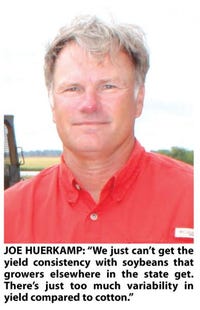
There will be an estimated 20,000 acres of cotton this year within a 15-mile radius of the new gin, he says. “That’s up from 5,000 acres just a couple of years ago, and we expect the availability of nearby ginning facilities will spur additional cotton acres in coming years.”
In 1982, the last year Valley Gin operated near here, Jack says, “they were running four bales per hour. The new gin will be state of the art, capable of ginning 60 bales per hour. It will rival 90 percent of the gins in the entire country and is being built not only to handle present-day production, but with capacity to handle expected expansion of acreage.
We’ll also have a seed storage warehouse.”
In addition to the employment the gin will provide, it will generate money for the community through trucking, sales, and other services, he says.
Joe and Tyler Huerkamp farm 2,000 acres of grains and cotton near Macon. They’ll have 1,700 acres of cotton this year, Joe says.
“I think we’ll be seeing a lot more cotton in this area as irrigation capability increases,” he says. “We just can’t get the yield consistency with soybeans that growers elsewhere in the state get. We ought to be able to get 80 bushels or more with irrigation, but there’s jus too much variability in yield compared to cotton.”
Tyler Huerkamp: 'Spectacular yields'
Tyler Huerkamp described 2011’s challenges and rewards for Mississippi Farm Country, the magazine of the Mississippi Farm Bureau Federation.
The year was “a rough start, a beautiful finish,” he wrote.
“New Year’s Eve brought a tornado and eight inches of rain. While we were very fortunate and suffered only minor damage, the storm demolished some neighboring farms.”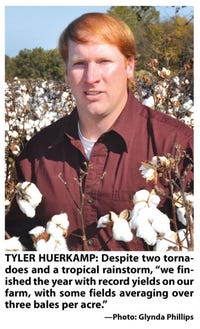
Another serious outbreak of storms occurred mid-April, spawning another tornado that hit an employee’s home and many surrounding homes and farms. After cleaning up the damage, the Huerkamps began preparations for planting cotton.
“April 27th brought the worst tornado outbreak of our lifetime,” Tyler wrote. In addition to numerous trees in fields, it destroyed a center pivot system that had been damaged in a windstorm two years earlier. The shop was a wreck, and I had to replant corn that was in the tornado’s path.”
Cotton planting got under way, with fairly normal weather for a month; then, June brought drought and “unbearably hot weather.” While cotton hadn’t started blooming and setting bolls, corn was in the pollination stage, and the heat took a toll on yield potential.
“The hot, dry start helped our cotton to develop a very extensive, strong root system,” and with normal irrigation, “the crop was shaping up to be a good one.”
Then, a tropical storm dumped 9 inches of rain on the farm. “But as the sun came out, damage was assessed and, amazingly, turned out to be minimal. The cotton crop was not injured badly, although the storm seemed to inhibit the defoliation process … and the maturing of the cotton seemed to be slowed and boll opening seemed more difficult.”
But as harvest got under way, Tyler wrote, “It was obvious that the drought and heat, sprinkled with a few timely rain showers through the growing season, had been nearly perfect for the crop. Excitement spread through the county at news of record yields being harvested.
“Despite all the trials the year brought, cotton yields were spectacular and we finished the year with record yields on our farm, with some fields averaging over three bales per acre.”
About the Author(s)
You May Also Like



